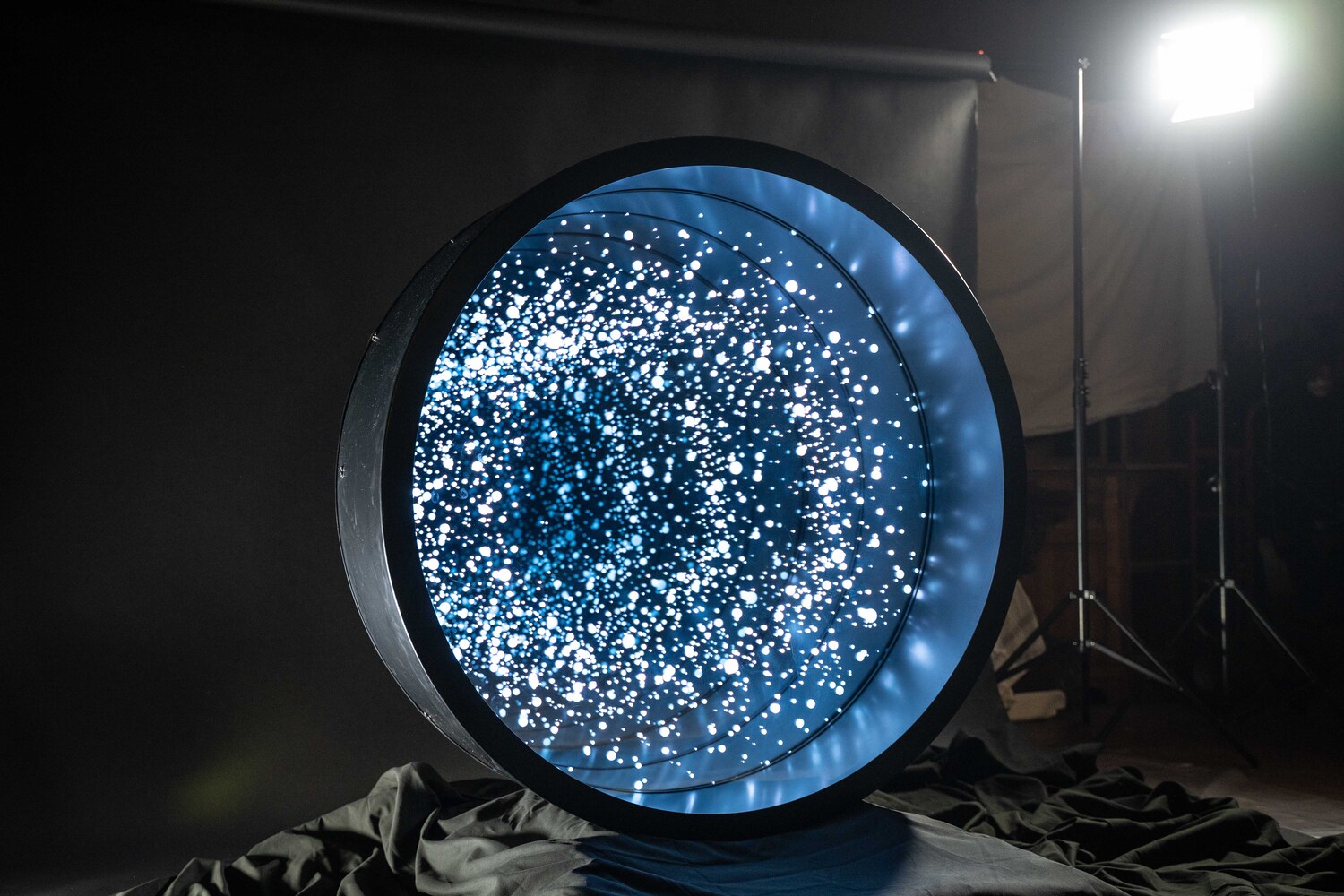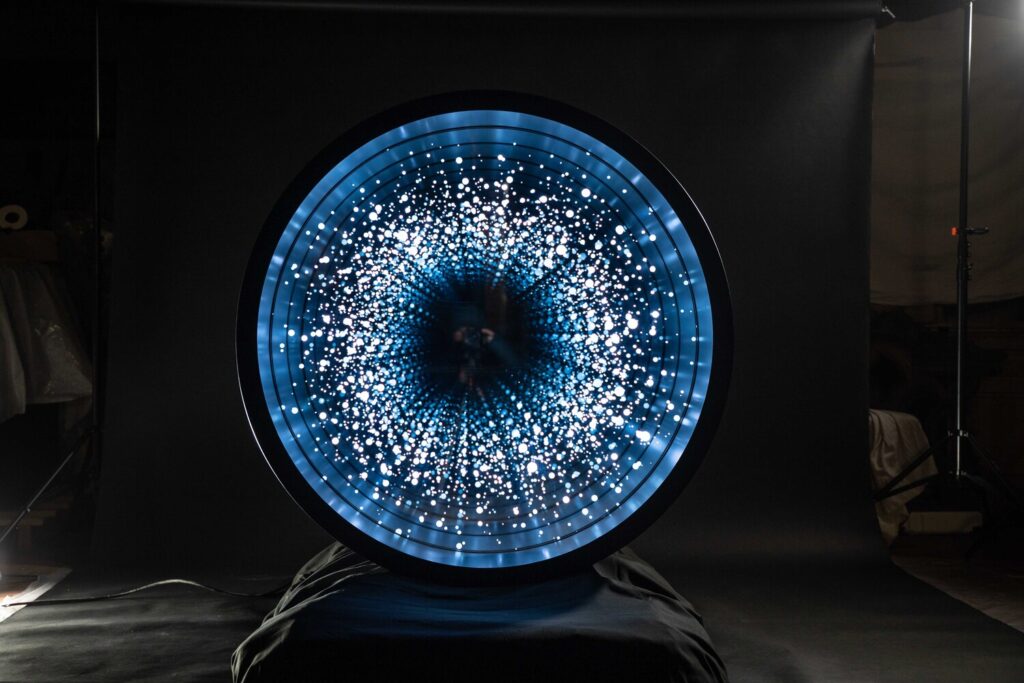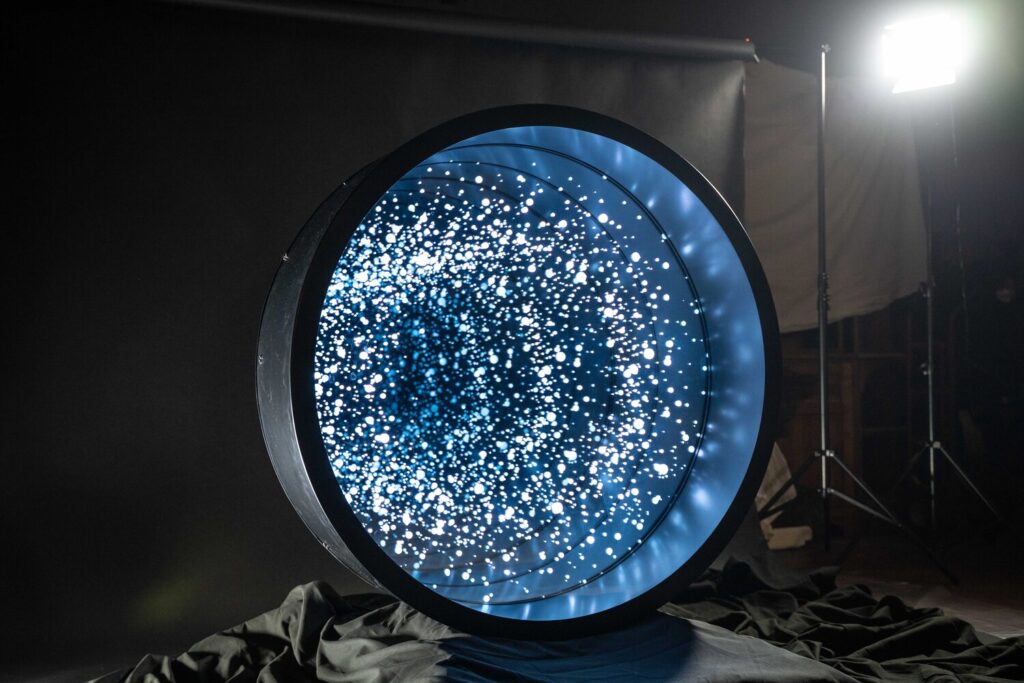
An artwork for Costa Crociere – Un’opera per Costa Crociere
One of the main goals of Art is to get straight to the heart of things, defying conventional ways of thinking and behaving. The pillar of Penelope’s work as an artist rests on a foundation of research into the origins of the Cosmos and life on our planet. Penelope uses the stars to symbolize the connection between our human existence, hosted on this sphere swirling through space, and the infinite vastness that surrounds it. The stars tear into human conventions causing our minds to hearken back to the origin of all that is. There is nothing wrong with human conventions. Remembering that we are made of stardust helps us maintain a proper perspective regarding our existence and truly comprehend the weight of our actions.
Stargazing means bringing distant concepts home.
It means journeying into the past, traveling through space-time.
Darkness returns every night to remind us of the Origins of Everything.
Una delle finalità dell’Arte è quella di andare alle radici delle cose, scardinare le abitudini e le convenzioni. Il pilastro della ricerca di Penelope è una riflessione sulle origini del Cosmo e della vita sulla Terra; le stelle sono il simbolo che utilizza per sottolineare questo aspetto dell’esistenza umana. La presenza delle stelle rompe le convenzioni umane, e riporta la mente all’origine di tutto. La riflessione parte dal fatto che non c’è nulla di sbagliato nelle convenzioni umane: ricordarsi che si proviene dalle stelle serve a ridimensionare e a capire il peso delle azioni umane.
Osservare le stelle significa portare concetti lontani a essere vicini.
Significa viaggiare nel passato, nello spazio-tempo.
Ogni notte ritorna il buio per ricordare le origini del Tutto.
A work of art for Costa Crociere
Title: “Star Gate”
Cylinder Ø 1228 mm x Depth 348 mm
Year 2021-2022
Technique: infinity mirror
Materials: stainless steel, electrical system, glass
Commissioned by Samuelis Baumgarte Galerie GmbH & Co. KG for Costa Crociere S.p.A.
Curtesy Costa Crociere – Samuelis Baumgarte Galerie
Navigators knew the star-studded Cosmos very well: this was the map by which they charted their course. With no landmarks, no coasts in sight, the sky with its fixed stars, traversed by the planets, the sun and the moon, became their map.
This navigation technique is among man’s oldest means of orientation and yet remains the most reliable still used today — even more reliable than satellite mapping.
When I was contacted by a German galley to create a new infinity mirror to be installed on a cruise ship, I immediately drew on these themes, and realized that this would have been an ideal setting for transmitting such significant notions to a vaster public. Creating an installation for a ship had profound implications: it would underscore the link between the Human and the Cosmic, those ever-present, gossamer threads that weave our human needs into a vaster fabric, rendering us insignificant dots against the infinite arena of the Cosmos.
I navigatori, quel Cosmo puntellato di stelle lo conoscevano benissimo: quella era la carta che dirigeva le loro rotte. Senza punti di riferimento terrestri, senza la costa in vista, il cielo con le sue stelle fisse, i pianeti, il sole e la luna diventavano la loro mappa.
Questa tecnica è fra le più antiche di orientamento in navigazione, e rappresenta il metodo più affidabile tra i tanti tutt’oggi in uso, più affidabile anche delle metodologie satellitari.
“Quando sono stata contattata da una galleria tedesca per realizzare un nuovo infinity mirror per una nave da crociera ho subito pensato a queste tematiche, e ho subito realizzato che sarebbe stato il palcoscenico ideale per portare questi temi così importanti al grande pubblico. Realizzare un’opera per una nave avrebbe avuto un significato molto forte: l’unione tra umano e cosmico, quella linea invisibile e sempre presente nella storia umana che collega le piccole necessità umane ai fili di un disegno molto più vasto, in cui siamo solo punti invisibili in una vasta arena cosmica.”

The work required two years of planning, analysis and constant study, not to mention extremely complex operations to physically create it.
The installation consists of a massive infinity mirror, which I have been working on in my studio so far. Creating this heavy, complicated piece required 120 kg of 316 grade stainless steel, otherwise known as “marine steel” which is not only employed for shipbuilding for yachts and other fine vessels, but also for manufacturing top-level pots and pans, since it allows food to be cooked at very high temperatures. It can resist the coldest environments, the most aggressive saltwater and the most corrosive acids.
L’opera per Costa Crociere ha richiesto due anni di analisi, progettazione e studio continui, nonché una realizzazione molto complessa.
Si tratta dell’infinity mirror più grande, pesante e articolato realizzato finora nel mio studio, ha richiesto 120 kg di acciaio inox 316, altrimenti denominato “inox marino”, non solo utilizzato per costruire yacht, navi e le barche più sofisticate, ma anche per fabbricare le migliori pentole: un materiale talmente nobile da essere il migliore per cuocere i cibi alle massime temperature. Resiste il freddo più rigido, la salsedine più aggressiva e gli acidi più forti.

The idea was to attach the mirror to the ceiling to give the illusion of a gash in the ship’s roof displaying the stars.
But attaching it to the ceiling required hundreds of calculations and ad hoc designs executed with the collaboration of the engineers working with me. This has been the first time that I created a piece designed for a space in constant movement, so necessitating a resistance to both dynamic and thermal shocks.
It was also the first time I created a round infinity mirror. This is far from an insignificant detail: this meant that creating it took over 100 hours!
It contains an actual map of the stars, showing their real positions across the firmament, both in honor of their historical use for navigation and as a reflection of the profound significance of my research.
L’idea era quella di fissare l’opera sul soffitto, in modo da dare l’illusione di un varco nella lamiera della nave, che mostrasse il cielo stellato. Ma per riuscire ad installarlo sul soffitto sono stati richiesti centinaia di calcoli e progettazioni ad hoc, realizzati insieme agli ingegneri con cui lo studio collabora. È stata infatti la prima opera che abbiamo dovuto costruire per un ambiente che si muove in continuazione, capace di resistere a shock sia dinamici che termici.
È stato il primo infinity mirror ad essere di forma circolare, e il dettaglio non è scontato: questa caratteristica ha aumentato il tempo di realizzazione di più di 100 ore.
Al suo interno, una mappa stellare reale, ossia la posizione reale delle stelle fisse nel cielo: un omaggio a questo storico metodo di navigazione, e anche un approfondimento della mia ricerca.

Aboard the ship, all the rooms and decks have Italian-inspired names.
This piece was installed at the prow of the Costa Toscana, in the hall known as Piazza dei Miracoli, where the inaugural press conference was staged.
The Italian Sanremo Song Festival, hosted by Fabio Rovazzi and Orietta Berti, was held on its stage for its 2022 edition on February 1-5.
Costa Toscana had a price tag of approximately 850 million euro. It is 337 m long (compared to the Titanic which was a mere 269 m) and 42 m wide.
It has a gross tonnage of 186,364 tons and can transport up to 6554 passengers in 2612 cabins.
The steel cutting ceremony took place August 19, 2019 at the shipyard in Meyer Turku, in Finland, where I delivered my piece. The ship was launched on May 16, 2022.
A bordo della nave, tutte le sale e i ponti hanno nomi ispirati all’Italia.
L’opera è stata installata a prua, nella Piazza dei Miracoli, il palcoscenico della Costa Toscana dove si è tenuta la conferenza stampa inaugurale.
Tra l’1 e il 5 febbraio 2022 è stata impiegata come palcoscenico del Festival di Sanremo, per la sezione condotta da Fabio Rovazzi e Orietta Berti.
Costa Toscana è costata approssimativamente 850 milioni di euro, è lunga 337 m (il Titanic era lungo 269 m) e larga 42 m.
Ha una stazza lorda di 186.364 tonnellate e trasporta fino a 6.554 passeggeri in 2.612 cabine.
Il taglio della prima lamiera è avvenuto il 19 agosto 2019, costruita presso il cantiere navale Meyer Turku, in Finlandia, dove ho consegnato la mia opera. Il battesimo è stato il 16 maggio 2022.



